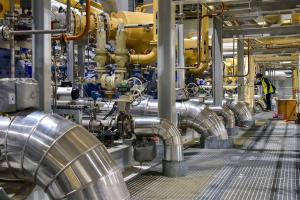The heat that came in from the cold
Reducing energy consumption is one of the major challenges of our time. It can be addressed at an individual level, like deciding to replace an old oil boiler with an efficient heat pump system or switching from incandescent light bulbs to LED lamps. It can also be addressed at a much larger scale by industry; modifying a production process, limiting energy losses through insulation or installing heat recovery devices are among the many ways industries can optimize consumption, cut back on spending and, ultimately, alleviate pressure on the planet's resources. Twenty years ago, France devised a system of incitement to promote such energy-saving initiatives. Under its terms, large companies such as electricity providers and fuel distributors have an obligation to financially support their clients' efforts to limit energy consumption by compensating part of their investment. A heat recovery system installed on the compressors of the ITER cryoplant was a recent beneficiary of this measure.
In order to provide cooling fluids to the machine, ITER operates one the largest cryoplants in the world. Inside the 6,000 m² facility, half of the available space is occupied by 18 megawatt-class compressors, arranged in trains of six, that feed cold boxes with gaseous helium at a pressure of 21 bars. Due to the monoatomic nature of helium, the compression process requires a lot of power and, being largely exothermic, generates a considerable quantity of heat. At full power, the electrical consumption of the cryoplant's helium compressors is equivalent to that of a town of 20,000 people. But only half of that power is consumed by the compression process proper, the rest being dissipated as heat by way of a water-cooling circuit.
Heat is a precious commodity, especially when a heat-producing device is located amid buildings and installations that need to be kept at room temperature during the cold season. "Notwithstanding France's incitement policy, it was clear from the beginning, in fact as early as the design phase, that we couldn't let such a massive quantity of heat be lost in the cooling circuit," explains David Grillot, the deputy head of the ITER Plant System Program, who oversaw the cryoplant's design as an engineer in 2012-2013 at Air Liquide.
When the liquid helium plant is fully operational, cooling water will come out of the compressors at a temperature of 100 °C and at a flow rate of approximately 2,500 m³ per hour. In the cold season, this flow will be diverted to the hot water boiler building, contributing 12 MW of heat to the ITER "central heating" system. And 12 MW is about all that is needed to keep the main facilities on the ITER platform at room temperature¹.
In the hot water boiler building, twin 13 MW electrical boilers operate as a redundant contingency system. One of them will kick in as soon as the hot water input from the compressors falls below 12 MW, as for example during maintenance phases. The boilers' contribution, and hence their electrical consumption, will be minimal as long as the liquid helium plant is operating.
"As a main actor in the French incitement scheme, the French utility EDF supported our project, which perfectly fit into the 'heat recovery in industrial systems' category," says David. "However EDF had never dealt with such a colossal case." ITER's contribution to cutting back on electricity spending was valued at EUR 5.5 million and the check arrived at the end of last year. "The sum is spectacular but it more or less amounts to what we spent installing the system." Now that the investment has been covered, massive savings are ahead: the buildings of the ITER scientific installation will be heated at very little energy cost and with significant benefits for the planet's resources.
¹Offices and secondary buildings have their own local heating systems, mostly in the form of heat pumps.



